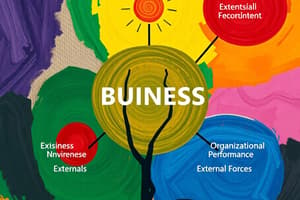Podcast
Questions and Answers
The general environment of an organization only includes competition-related factors.
The general environment of an organization only includes competition-related factors.
False (B)
Environmental uncertainty refers to both the degree of change and complexity within an organization's external environment.
Environmental uncertainty refers to both the degree of change and complexity within an organization's external environment.
True (A)
A competitive environment is solely focused on a company's internal resources and capabilities.
A competitive environment is solely focused on a company's internal resources and capabilities.
False (B)
Technological factors in the general environment only pertain to the availability of advanced machinery.
Technological factors in the general environment only pertain to the availability of advanced machinery.
Demographic factors in the external environment encompass characteristics like age, gender, and race.
Demographic factors in the external environment encompass characteristics like age, gender, and race.
The extent of an organization’s involvement in international business is referred to as the international general environment.
The extent of an organization’s involvement in international business is referred to as the international general environment.
Economic factors affecting organizations include unemployment rates and inflation.
Economic factors affecting organizations include unemployment rates and inflation.
Political and legal factors are unimportant for businesses operating in stable economies.
Political and legal factors are unimportant for businesses operating in stable economies.
The stronger the rivalry among competitors, the higher the level of industry profits.
The stronger the rivalry among competitors, the higher the level of industry profits.
Organizational culture can be visibly observed through artefacts such as manner of dress and organizational ceremonies.
Organizational culture can be visibly observed through artefacts such as manner of dress and organizational ceremonies.
A weak organizational culture is characterized by a strong connection between behaviors and values shared across the organization.
A weak organizational culture is characterized by a strong connection between behaviors and values shared across the organization.
The bargaining power of suppliers increases when customers can easily switch to alternative suppliers.
The bargaining power of suppliers increases when customers can easily switch to alternative suppliers.
Porter's five forces model analyzes the attractiveness of an industry based solely on customer demographics.
Porter's five forces model analyzes the attractiveness of an industry based solely on customer demographics.
Stakeholders include only external groups, such as customers and suppliers.
Stakeholders include only external groups, such as customers and suppliers.
Adaptability in organizational culture refers to employees being discouraged from taking risks and experimenting.
Adaptability in organizational culture refers to employees being discouraged from taking risks and experimenting.
An organization’s culture is solely established by top management without any influence from employees.
An organization’s culture is solely established by top management without any influence from employees.
The threat of substitutes is higher when products in other industries serve similar needs and functions.
The threat of substitutes is higher when products in other industries serve similar needs and functions.
Customers expect to receive quality products at prices they have already agreed upon with the distributors.
Customers expect to receive quality products at prices they have already agreed upon with the distributors.
A company’s bargaining power of buyers is stronger when customers are few in number and there are available alternatives.
A company’s bargaining power of buyers is stronger when customers are few in number and there are available alternatives.
The degree of team orientation in an organization's culture indicates how much collaboration is discouraged among employees.
The degree of team orientation in an organization's culture indicates how much collaboration is discouraged among employees.
All stakeholders have identical claims and priorities regarding a company's performance and operations.
All stakeholders have identical claims and priorities regarding a company's performance and operations.
The degree of integrity within an organization’s culture reflects the extent to which high ethical principles are valued.
The degree of integrity within an organization’s culture reflects the extent to which high ethical principles are valued.
The number of competitors in an industry has no impact on the level of rivalry experienced.
The number of competitors in an industry has no impact on the level of rivalry experienced.
Underlying assumptions in organizational culture are typically observable through direct assessment.
Underlying assumptions in organizational culture are typically observable through direct assessment.
Flashcards
Business Environment
Business Environment
The factors outside of an organization that can affect its performance.
Environmental Uncertainty
Environmental Uncertainty
The degree to which an organization's environment is changing and the number of factors it needs to consider.
General Environment
General Environment
The broad environmental factors that affect all organizations, such as political, economic, social, and technological factors.
Competitive Environment
Competitive Environment
Signup and view all the flashcards
Economic Environment
Economic Environment
Signup and view all the flashcards
Technological Environment
Technological Environment
Signup and view all the flashcards
Political and Legal Environment
Political and Legal Environment
Signup and view all the flashcards
PESTEL Analysis
PESTEL Analysis
Signup and view all the flashcards
Porter's Five Forces Model
Porter's Five Forces Model
Signup and view all the flashcards
Rivalry Among Competitors
Rivalry Among Competitors
Signup and view all the flashcards
Threat of New Entrants
Threat of New Entrants
Signup and view all the flashcards
Bargaining Power of Suppliers
Bargaining Power of Suppliers
Signup and view all the flashcards
Bargaining Power of Buyers
Bargaining Power of Buyers
Signup and view all the flashcards
Threat of Substitutes
Threat of Substitutes
Signup and view all the flashcards
Organizational Culture
Organizational Culture
Signup and view all the flashcards
Strong Culture
Strong Culture
Signup and view all the flashcards
Weak Culture
Weak Culture
Signup and view all the flashcards
Visible Artifacts
Visible Artifacts
Signup and view all the flashcards
Invisible Elements
Invisible Elements
Signup and view all the flashcards
Stakeholders
Stakeholders
Signup and view all the flashcards
External Stakeholders
External Stakeholders
Signup and view all the flashcards
Internal Stakeholders
Internal Stakeholders
Signup and view all the flashcards
Study Notes
Business Environment
- Environment encompasses external institutions affecting an organization's performance.
- Environmental uncertainty, characterized by change and complexity, impacts performance.
- Change: Frequency of environmental component shifts.
- Complexity: Number of components and organizational knowledge about them.
General Environment
- Organization's external environment includes:
- General environment: Affects all organizations (political, economic, socio-cultural, technological, environmental, and legal factors).
- Competitive environment: Industry-specific (customers, suppliers, competitors).
Major Forces in General Environment
- Economic: Interest rates, inflation, unemployment, economic growth.
- Technological: Infrastructure, advancements, industrial innovations, production/distribution methods.
- Political & Legal: Political stability, government regulations, laws & regulations.
- Socio-cultural: Customs, values, traditions, lifestyles, beliefs, behavior patterns.
- Demographic: Population characteristics (age, gender, ethnicity, race, sexual orientation, social class).
- Environmental: Production methods, sustainable consumption, climate change.
- International: Involvement/influence of other countries.
International PESTEL Analysis
- Political: Foreign investment attitudes, political stability, IP policies.
- Economic: Growth rates, wealth distribution, currency stability, exchange rates.
- Socio-cultural: National cultures, attitudes towards foreign companies.
- Technological: Telecommunications, power supply, import/export infrastructure.
- Environmental: Natural resources, environmental quality, climate change effects.
- Legal: Tariffs, trade agreements, employment protection, company taxation.
Competitive Environment
- Competitive environment comprises forces from suppliers, distributors, customers, and competitors.
- Suppliers: Provide input resources.
- Distributors: Help sell goods/services to customers.
- Customers: Purchase goods/services.
- Competitors: Offer similar goods/services.
Porter's Five Forces Model
- Analyzes industry attractiveness.
- Rivalry among competitors: Higher rivalry = lower industry profits.
- Number of competitors, demand growth, product differentiation, barriers to exit influence rivalry.
- Threat of new entrants: Lower barriers to entry = lower industry profits.
- Barriers include capital investment, economies of scale, special licenses, and customer loyalty.
- Bargaining power of suppliers: Strong suppliers = lower industry profits.
- Supplier count, customer purchasing habits, supplier expansion potential, supplier-switching costs.
- Bargaining power of buyers: Strong buyers = lower industry profits.
- Threat of substitutes: Alternative products satisfying similar needs.
- Rivalry among competitors: Higher rivalry = lower industry profits.
Organizational Culture
- Internal environment includes people, culture, structure, and technology.
- Organizational culture: Shared values, principles, traditions, influencing ways of doing things.
- Strong culture: Behaviors align with widely shared values; employee identification, stories about company history.
- Weak culture: Values limited to top management; employees don't identify with the culture.
- Levels of organizational culture:
- Visible artifacts: Observable elements (dress, behavior, symbols, ceremonies, office layout).
- Invisible levels:
- Values and beliefs: Interpretable from stories, language, symbols.
- Underlying assumptions: Subconscious guides to behavior (role models, legends, nicknames, coded language).
- Dimensions of organizational culture:
- Adaptability, attention to detail, outcome orientation, people orientation, team orientation, integrity.
- Establishing organizational culture:
- Founder's vision, stories, material symbols, language, selection, socialization processes, top management actions.
Stakeholders
- Stakeholders: Individuals/groups with interest, claims, or stake in the company's performance.
- Categories:
- External Stakeholders: Customers, suppliers, creditors, governments, unions, communities, general public.
- Internal Stakeholders: Stockholders, employees, managers, executives, board members.
- Stakeholder claims:
- Stockholders: Maximize return on investment.
- Managers: Decide optimal stakeholder goals, resource allocation.
- Employees: Fair rewards for performance.
- Suppliers: Fair and timely payment.
- Distributors: Quality products at agreed prices.
- Customers: Company needs attraction to remain viable.
- Community: Provides physical and social infrastructure.
Studying That Suits You
Use AI to generate personalized quizzes and flashcards to suit your learning preferences.




